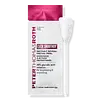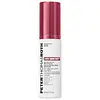What's inside
What's inside
 Key Ingredients
Key Ingredients

 Benefits
Benefits

 Concerns
Concerns

 Ingredients Side-by-side
Ingredients Side-by-side

Water
Skin ConditioningGlycolic Acid
BufferingPotassium Hydroxide
BufferingNiacinamide
SmoothingAcetyl Hexapeptide-8
HumectantPalmitoyl Tripeptide-38
Skin ConditioningPalmitoyl Tripeptide-5
Skin ConditioningAdenosine
Skin ConditioningHyaluronic Acid
HumectantSodium Hyaluronate
HumectantPotassium Sorbate
PreservativeSodium Benzoate
MaskingPotassium Hyaluronate
Skin ConditioningHydrolyzed Sodium Hyaluronate
Skin ConditioningSodium Hyaluronate Crosspolymer
HumectantSodium Acetylated Hyaluronate
HumectantAllantoin
Skin ConditioningPinus Sylvestris Leaf Extract
TonicIllicium Verum Fruit Extract
PerfumingCitric Acid
BufferingCaprylyl Glycol
EmollientButylene Glycol
HumectantPentylene Glycol
Skin ConditioningSodium Gluconate
Skin ConditioningDipropylene Glycol
HumectantHydroxyacetophenone
AntioxidantDipotassium Glycyrrhizate
Humectant1,2-Hexanediol
Skin ConditioningHydroxypropyl Cyclodextrin
MaskingWater, Glycolic Acid, Potassium Hydroxide, Niacinamide, Acetyl Hexapeptide-8, Palmitoyl Tripeptide-38, Palmitoyl Tripeptide-5, Adenosine, Hyaluronic Acid, Sodium Hyaluronate, Potassium Sorbate, Sodium Benzoate, Potassium Hyaluronate, Hydrolyzed Sodium Hyaluronate, Sodium Hyaluronate Crosspolymer, Sodium Acetylated Hyaluronate, Allantoin, Pinus Sylvestris Leaf Extract, Illicium Verum Fruit Extract, Citric Acid, Caprylyl Glycol, Butylene Glycol, Pentylene Glycol, Sodium Gluconate, Dipropylene Glycol, Hydroxyacetophenone, Dipotassium Glycyrrhizate, 1,2-Hexanediol, Hydroxypropyl Cyclodextrin
Water
Skin ConditioningGlycolic Acid
BufferingPropanediol
SolventSodium Hydroxide
BufferingSimmondsia Chinensis Seed Oil
EmollientEthylhexyl Olivate
Skin ConditioningPolyglyceryl-2 Distearate
EmulsifyingC9-12 Alkane
SolventArachidyl Alcohol
EmollientZea Mays Starch
AbsorbentGlyceryl Stearate
EmollientNiacinamide
SmoothingTocopherol
AntioxidantAdansonia Digitata Seed Oil
EmollientCucurbita Pepo Seed Oil
EmollientRetinol
Skin ConditioningCollagen
MoisturisingAdenosine
Skin ConditioningSqualane
EmollientAllantoin
Skin ConditioningAscorbic Acid
AntioxidantPanthenol
Skin ConditioningLecithin
EmollientCeramide NP
Skin ConditioningVolcanic Soil
Skin ConditioningPullulan
Sodium Phytate
Arachidyl Glucoside
EmulsifyingAmylopectin
Polysorbate 20
Emulsifying1,2-Hexanediol
Skin ConditioningSilica
AbrasiveSodium Hyaluronate
HumectantLeuconostoc/Radish Root Ferment Filtrate
AntimicrobialPotassium Sorbate
PreservativeSclerotium Gum
Emulsion StabilisingCoco-Caprylate/Caprate
EmollientSodium Benzoate
MaskingXanthan Gum
EmulsifyingLysolecithin
EmulsifyingPentylene Glycol
Skin ConditioningPotassium Phosphate
BufferingEthylhexylglycerin
Skin ConditioningBehenyl Alcohol
EmollientAlcohol
AntimicrobialPhenoxyethanol
PreservativeMica
Cosmetic ColorantWater, Glycolic Acid, Propanediol, Sodium Hydroxide, Simmondsia Chinensis Seed Oil, Ethylhexyl Olivate, Polyglyceryl-2 Distearate, C9-12 Alkane, Arachidyl Alcohol, Zea Mays Starch, Glyceryl Stearate, Niacinamide, Tocopherol, Adansonia Digitata Seed Oil, Cucurbita Pepo Seed Oil, Retinol, Collagen, Adenosine, Squalane, Allantoin, Ascorbic Acid, Panthenol, Lecithin, Ceramide NP, Volcanic Soil, Pullulan, Sodium Phytate, Arachidyl Glucoside, Amylopectin, Polysorbate 20, 1,2-Hexanediol, Silica, Sodium Hyaluronate, Leuconostoc/Radish Root Ferment Filtrate, Potassium Sorbate, Sclerotium Gum, Coco-Caprylate/Caprate, Sodium Benzoate, Xanthan Gum, Lysolecithin, Pentylene Glycol, Potassium Phosphate, Ethylhexylglycerin, Behenyl Alcohol, Alcohol, Phenoxyethanol, Mica
Ingredients Explained
These ingredients are found in both products.
Ingredients higher up in an ingredient list are typically present in a larger amount.
1,2-Hexanediol is a synthetic liquid and another multi-functional powerhouse.
It is a:
- Humectant, drawing moisture into the skin
- Emollient, helping to soften skin
- Solvent, dispersing and stabilizing formulas
- Preservative booster, enhancing the antimicrobial activity of other preservatives
Adenosine is in every living organism. It is one of four components in nucleic acids that helps store our DNA.
Adenosine has many benefits when used. These benefits include hydrating the skin, smoothing skin, and reducing wrinkles. Once applied, adenosine increases collagen production. It also helps with improving firmness and tissue repair.
Studies have found adenosine may also help with wound healing.
In skincare products, Adenosine is usually derived from yeast.
Learn more about AdenosineAllantoin is a soothing ingredient known for its protective and moisturizingg properties. Because of this, it is often added to products with strong active ingredients.
Studies show higher concentrations of this ingredient can promote wound healing.
Though it can be derived from the comfrey plant, allantoin is produced synthetically for cosmetic products to ensure purity.
Learn more about AllantoinGlycolic Acid is arguably the most famous alpha hydroxy acid (AHA) with tons of research backing its benefits.
It is found naturally in sugar cane but the form used in skincare is usually synthetic for purity and stability.
Glycolic acid removes the top layer of dead skin cells to allow newer and fresher ones to emerge.
AHAs work by breaking down the structural “glue” that holds old skin cells in place. When that buildup is gone, your skin can renew itself more efficiently.
Research also shows glycolic acid stimulates collagen production, helping to firm and thicken the skin over time. This is one of its biggest advantages over other AHAs.
Overall, glycolic acid helps with:
Fun fact: Glycolic acid boosts skin hydration by helping it produce molecules that increase hyaluronic acid naturally.
To work best, glycolic acid products should have a pH between 3-4 (that’s where exfoliation is most effective but still gentle on skin).
The pH and concentration of a product are key to its effectiveness:
It is normal to feel a slight stinging sensation when using glycolic acid. This usually fades as your skin adjusts.
Because glycolic acid has the smallest molecular size in the AHA family, it can penetrate deeper, which enhances its effectiveness but also makes it more likely to irritate sensitive skin.
If your skin is very sensitive or prone to rosacea, glycolic acid may be too strong; in that case, try milder options like lactic acid or a PHA instead.
Recent studies suggest glycolic acid might even help protect against UV damage. But don’t skip sunscreen! Freshly exfoliated skin is more sensitive to the sun.
Glycolic acid is a skincare superstar. It smooths, brightens, hydrates, and firms the skin. Unless you’re highly sensitive, it’s well worth adding to your routine.
Read more about some other popular AHA's here:
Learn more about Glycolic AcidNiacinamide is a multitasking form of vitamin B3 that strengthens the skin barrier, reduces pores and dark spots, regulates oil, and improves signs of aging.
And the best part? It's gentle and well-tolerated by most skin types, including sensitive and reactive skin.
You might have heard of "niacin flush", or the reddening of skin that causes itchiness. Niacinamide has not been found to cause this.
In very rare cases, some individuals may not be able to tolerate niacinamide at all or experience an allergic reaction to it.
If you are experiencing flaking, irritation, and dryness with this ingredient, be sure to double check all your products as this ingredient can be found in all categories of skincare.
When incorporating niacinamide into your routine, look out for concentration amounts. Typically, 5% niacinamide provides benefits such as fading dark spots. However, if you have sensitive skin, it is better to begin with a smaller concentration.
When you apply niacinamide to your skin, your body converts it into nicotinamide adenine dinucleotide (NAD). NAD is an essential coenzyme that is already found in your cells as "fuel" and powers countless biological processes.
In your skin, NAD helps repair cell damage, produce new healthy cells, support collagen production, strengthen the skin barrier, and fight environmental stressors (like UV and pollution).
Our natural NAD levels start to decline with age, leading to slower skin repair, visible aging, and a weaker skin barrier. By providing your skin niacinamide, you're recharging your skin's NAD levels. This leads to stronger, healthier, and younger looking skin.
Another name for vitamin B3 is nicotinamide. This vitamin is water-soluble and our bodies don't store it. We obtain Vitamin B3 from either food or skincare. Meat, fish, wheat, yeast, and leafy greens contain vitamin B3.
The type of niacinamide used in skincare is synthetically created.
Learn more about NiacinamidePentylene glycol is typically used within a product to thicken it. It also adds a smooth, soft, and moisturizing feel to the product. It is naturally found in plants such as sugar beets.
The hydrophilic trait of Pentylene Glycol makes it a humectant. As a humectant, Pentylene Glycol helps draw moisture from the air to your skin. This can help keep your skin hydrated.
This property also makes Pentylene Glycol a great texture enhancer. It can also help thicken or stabilize a product.
Pentylene Glycol also acts as a mild preservative and helps to keep a product microbe-free.
Some people may experience mild eye and skin irritation from Pentylene Glycol. We always recommend speaking with a professional about using this ingredient in your routine.
Pentylene Glycol has a low molecular weight and is part of the 1,2-glycol family.
Learn more about Pentylene GlycolPotassium Sorbate is a preservative used to prevent yeast and mold in products. It is commonly found in both cosmetic and food products.
This ingredient comes from potassium salt derived from sorbic acid. Sorbic acid is a natural antibiotic and effective against fungus.
Both potassium sorbate and sorbic acid can be found in baked goods, cheeses, dried meats, dried fruit, ice cream, pickles, wine, yogurt, and more.
You'll often find this ingredient used with other preservatives.
Learn more about Potassium SorbateSodium Benzoate is a preservative. It's used in both cosmetic and food products to inhibit the growth of mold and bacteria. It is typically produced synthetically.
Both the US FDA and EU Health Committee have approved the use of sodium benzoate. In the US, levels of 0.1% (of the total product) are allowed.
Sodium benzoate works as a preservative by inhibiting the growth of bacteria inside of cells. It prevents the cell from fermenting a type of sugar using an enzyme called phosphofructokinase.
It is the salt of benzoic acid. Foods containing sodium benzoate include soda, salad dressings, condiments, fruit juices, wines, and snack foods.
Studies for using ascorbic acid and sodium benzoate in cosmetics are lacking, especially in skincare routines with multiple steps.
We always recommend speaking with a professional, such as a dermatologist, if you have any concerns.
Learn more about Sodium BenzoateSodium Hyaluronate is hyaluronic acid's salt form. It is commonly derived from the sodium salt of hyaluronic acid.
Like hyaluronic acid, it is great at holding water and acts as a humectant. This makes it a great skin hydrating ingredient.
Sodium Hyaluronate is naturally occurring in our bodies and is mostly found in eye fluid and joints.
These are some other common types of Hyaluronic Acid:
Learn more about Sodium HyaluronateWater. It's the most common cosmetic ingredient of all. You'll usually see it at the top of ingredient lists, meaning that it makes up the largest part of the product.
So why is it so popular? Water most often acts as a solvent - this means that it helps dissolve other ingredients into the formulation.
You'll also recognize water as that liquid we all need to stay alive. If you see this, drink a glass of water. Stay hydrated!
Learn more about Water